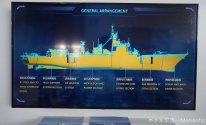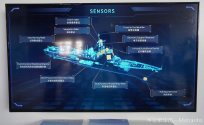So in you guys' opinions, what would be the more likely, undisclosed, actual range for YJ-18?
Anything between 600km and 690km lol. I don't think we'll see an exact figure, just as we don't know the exact range of most missiles.
It's also important to remember that cruise missiles can fly longer distances in a high-low profile:
"Flying at high altitude can extend the range of the missile because it’s more fuel-efficient than flying at lower altitudes. However, this also makes the missile more susceptible to missile defense systems since today’s radars and sensors are typically positioned to detect and track high altitude threats.
Cruise missiles can also mix their flight trajectory between high and low altitude in order to get the benefits of both."
from
So in short, range estimates are always rather unreliable, especially public-facing ones. The block V Tomahawk is stated as having a range of "more than 1600km", but think tanks often state its range as close to 2500km, presumably in a high-low profile. The exact flight profile associated with an exact range would be considered highly classified by any military.
I think the jet engine of the YJ-18 is based on reverse-engineered Tomahawk engines, and if it's as efficient, the missile should have approximately 40% of its range based on its profile. 40% of 1600km is 640km. The ca. 20km range of the supersonic stage would come on top of that. So that would give it ca. 660km in a low flight profile, and potentially more than 1000km if travelling at higher altitudes, but then its no longer stealthy and easy to detect and shoot down.
As you can see, that's just an educated guess with some rough calculations. But it all fits together rather nicely into the space between 600 and 690km.
To my mind, the bigger question with the YJ-18 is how it gets mid-course correction at low altitudes. The active seeker can only guide it during the last phase of the flight when the supersonic stage separates (ca. 20km from the target) and it takes a cruise missile 40minutes to travel 600km. A ship at 20kn would travel 24.7km in that time, so it could be easy to miss. Besides, the OTH Type 366 radar has an estimated range against a destroyer-sized target of max 450km; of course it could be more, but that would bring us back to the problem that the target could have moved too far to still be detected by the active seeker.
I speculate that the kill chain of the YJ-18 (and YJ-21 etc.) primarily involves satellite detection and mid-course updates and that the Type 366 radar is still in service for redundancy. In addition, high-altitude drones such as the WZ-8 provide can do the job if satellites are shot down
. So that would make it a system with 3 layers of redundancy, which fits with everything the PLA does; e.g. the islands in the South China Sea also have multiple redundant layers of communication etc. All in line with the doctrine of "system destruction" and "systems of systems". US systems tend to have single points of failure, e.g. by having only GPS targeting or reliance on aerial refueling and vulnerable logistics ships. So even if overall US systems have superior performance than PLA ones ("F-35 vs J-20", "052D vs Burke" etc.), it does not matter because the PLA does not intend to fight them until they are heavily degraded (the Arleigh Burke-class is thirsty with its 4 gas turbines, and the USN has vulnerable tankers and unprotected fuel storage; F-35 is complicated to maintain so unlikely that it can operate from distributed bases like a Mig-29 can).
On the other hand, even if an export customer gets the YJ-18 and the 052D without any downgrades*, they couldn't use it to the same extent as the PLAN because it's only part of a much larger system that its designed to plug into. But it would be more than sufficient for defending against Houthi missiles and firing cruise missiles into Yemen.
By the way, I find it super interesting how China manages to do business with both the Saudis and Iran with Xi visiting both in short order, in addition China sells weapons to the Arabs who regard Iran as their primary threat.
*(We can be pretty sure that the 052DE specs at Zuhai were downgraded: slower (28kn vs 30kn), shorter (159m vs 161m) and the old anti-stealth radar. The slower speed likely results from not having the intermediate cooling that was added to the gas turbine on the 052D over the 052C, but much more important is that the electrical generators would also have lower performance with less cooling. The shorter hull length suggests that the gensets would need to be smaller too as the 052D is pretty tight internally. So almost certainly less electrical power resulting in worse sensor performance and no space for future upgrades.)







